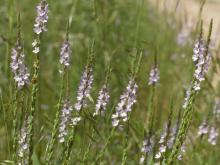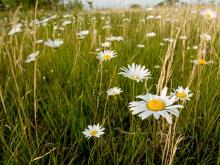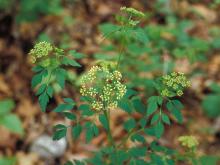Wildflowers, Grasses and Other Nonwoody Plants
Media
Species Types
Scientific Name
Vernonia baldwinii
Description
Ironweeds are tough, grayish-green, branching plants known for their fluffy-looking clusters of reddish-purple florets. They are a familiar sight on roadsides and pastures. Identify western ironweed by the bracts at the base of the flowerheads.
Media

Species Types
Scientific Name
Melilotus albus and M. officinale
Description
These two species of sweet clover are present all over America. Although they have been planted for forage, as bee plants, and as nitrogen-fixers, white and yellow sweet clover are now classified as invasive for their weediness and the problems they pose for natural habitats.
Media

Species Types
Scientific Name
Fragaria virginiana
Description
Wild strawberry is one of the parents of the cultivated strawberry and is one of our prized native wild edibles. It’s also a valuable food for innumerable animals, and it’s attractive in native wildflower gardens.
Media

Species Types
Scientific Name
Potentilla simplex
Description
Common cinquefoil, or five-finger, is named for its leaves, which are divided into five fingerlike leaflets. One of seven cinquefoils in Missouri, it blooms from April to June and is scattered nearly statewide.
Media

Species Types
Scientific Name
Solidago spp. (23 species in Missouri)
Description
There are 23 species of goldenrods in Missouri. They can be hard to identify to species, but as a group, the goldenrods are common and nearly unmistakable.
Media

Species Types
Scientific Name
Verbena simplex
Description
Narrow-leaved vervain is a short, slender perennial with single stems or with upper stems sparingly branched. Its many small flowers are crowded on narrow spikes. The corollas are tubular, deep lavender or purple, with 5 spreading lobes.
Media

Species Types
Scientific Name
Solanum carolinense
Description
Horse nettle is a native perennial with spiny stems and leaves, white to purplish flowers, and toxic fruits that look like tiny yellow tomatoes. It does well in disturbed habitats, and many people consider it a weed.
Media

Species Types
Scientific Name
Leucanthemum vulgare (formerly Chrysanthemum leucanthemum)
Description
Ox-eye daisy, though familiar, is not native to North America. It was introduced long ago from Eurasia. Common in grassy uplands, pastures, fencerows, and roadsides, it can colonize aggressively in the garden.
Media

Species Types
Scientific Name
Zizia aurea
Description
Named for its resemblance to a European herb that was popular in Medieval times, golden Alexanders is a native Missouri wildflower with bright yellow flowers arranged in umbrella-like clusters.
Media

Species Types
Scientific Name
All true grasses (species in the grass family)
Description
Missouri has 276 species in the grass family, including well-known crop plants and our native prairie grasses. Distinguishing between the species can be difficult, but it’s easy to learn some basics about the group.
See Also
About Wildflowers, Grasses and Other Nonwoody Plants in Missouri
A very simple way of thinking about the green world is to divide the vascular plants into two groups: woody and nonwoody (or herbaceous). But this is an artificial division; many plant families include some species that are woody and some that are not. The diversity of nonwoody vascular plants is staggering! Think of all the ferns, grasses, sedges, lilies, peas, sunflowers, nightshades, milkweeds, mustards, mints, and mallows — weeds and wildflowers — and many more!





















